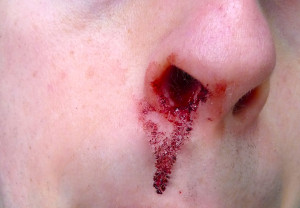Introduction
Nosebleeds are common, but there are a great number of reasons for a nose bleed to occur, from the innocent dry mucous membrane to a serious intranasal tumor.
Fortunately most nose bleeds are only a nuisance, but occasionally life threatening blood loss can result from them, so each nose bleed should be viewed with caution and a physician should find out the cause in the particular patient. Here are a few of the common causes of nose bleeds (compiled from text of Ref. 4, p. 1747).
Symptoms
Most nose bleeds stop spontaneously with pressure after some time. However, when the patient has a blood coagulation problem, high blood pressure or a ruptured blood vessel of a nasopharyngeal angiofibroma profuse bleeding can occur, which is considered a medical emergency.
Common causes of nosebleeds
| Medical condition: | Comments: |
| infections of sinuses, rhinitis, cold | viral, bacterial, fungal infections leading to inflammation |
| allergic rhinitis | swelling and itching causing picking of nose |
| dry air in heating season | dryness leads to breakdown of mucous membrane and bleeding |
| juvenile nasopharyngeal angiofibroma | common in adolescent males |
| blood thinning | hereditary coagulopathies; coumadin, ASA or heparin. |
| patients with high blood pressure | arteries are more rigid in these patients leading to more profuse bleeding |
Treatment
In an emergency the physician may have to stop an acute bleed through a procedure called tamponade where packing is applied into the affected nostril.
There are probes that can be inserted and inflated. Also, an ENT surgeon could stop a nosebleed by cauterizing the bleeding blood vessel in the anesthetized patient. The underlying condition (see table) has to be addressed by appropriate therapy. With repeat nose bleeds the treating physician makes a referral to an ENT specialist to rule out any more serious condition (like cancer). If the bleed is due to prominent dilated superficial veins in the mucous membranes of the nasal cavity, this can be remedied by cauterization of these under a local anesthetic.
References
1. James Chin et al., Editors: Control of Communicable Diseases Manual, 17th edition, 2000, American Public Health Association.
2. Behrman: Nelson Textbook of Pediatrics, 16th ed., 2000, W. B. Saunders Company
3. J M Hickner et al. Ann Emerg Med 37(6): 703-710. June 2001.
4. Noble: Textbook of Primary Care Medicine, 3rd ed.,2001 Mosby, Inc.
5. Abeloff: Clinical Oncology, 2nd ed.,2000,Churchill Livingstone, Inc.
6. Ferri: Ferri’s Clinical Advisor: Instant Diagnosis and Treatment, 2004 ed., Copyright © 2004 Mosby, Inc.
7. Rakel: Conn’s Current Therapy 2004, 56th ed., Copyright © 2004 Elsevier







